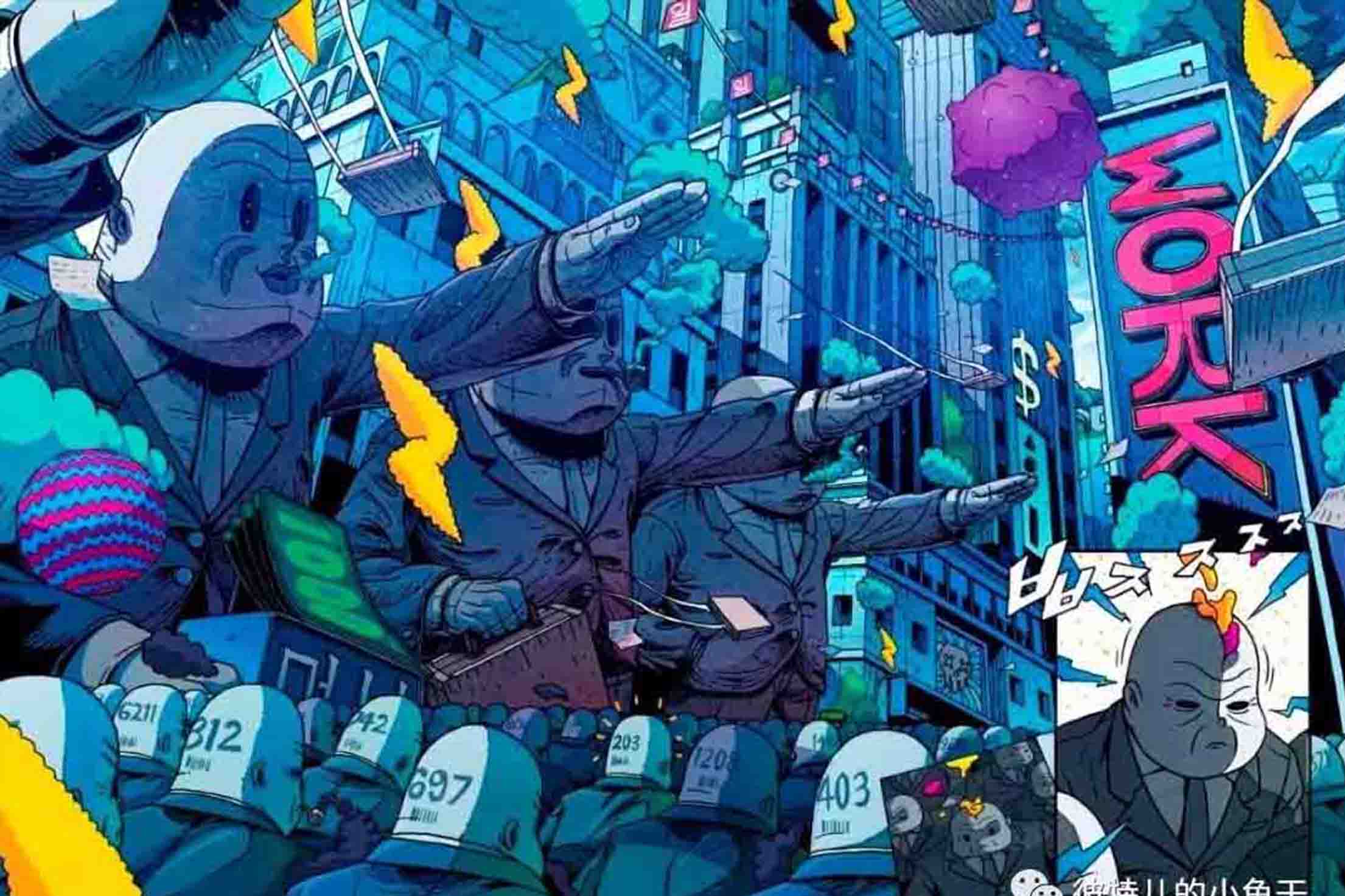图片引自和平里设计师 七七 的作品「数不明白的J」 做「胖车库」这个播客的初心,是因为之前接触过很多的开发者,和他们聊过。他们其实并不被很多人所了解,大多数人只知道:开发者很重要,很重要,很重要。
其实,他们有很多故事值得被了解。
他们很自由,这种自由倾向于思想的自由。我接触到的他们中绝大部分不愿受到体制、规则等条框的束缚,他们认为不断的发现问题并解决问题是有意义的,重复进行没有价值增值的工作是在浪费生命。
I work for MYSELF, not for anyone else。

图片引自韩国插画师 Ju Yong Lee的作品「现代生活是垃圾」
这尼玛何止是极客精神,更是这个时代应该有的企业家精神好吗。
他们参加各种Hackathon,和世界任何地方的人协作,关注行业里面的动向和问题所在,时刻要保证技能跟上。
他们可以快速地接受和学习新事物,并马上寻找应用场景、试验,咨询,推翻,再来。
他们也渴望受到激励,只不过更任性一点,对于自己不感兴趣的东西,会果断放弃。
Life is about creating something you passionate about ,if not just PIVOT it and create LUCK for yourself.

图片引自韩国插画师 Ju Yong Lee的作品「现代生活是垃圾」
我之前写过一些文字来记录这些对话,但也因为自己喜爱听一些播客的缘故,感觉言语之间可能会有更多的启发和火花。
在这些想法泡汤之前,我跑去和Stefan打了招呼,我说兄弟我想做一个这样的聊天节目bulabula,于是…就有了第一期。
我和Stefan是在Consensys办的第一场线上Hackathon中认识,在Consensys之后陆续发起的几次Hackathon期间一直保持着联系。Stefan曾是软件工程服务商Cadence的高级开发者,主要负责研究如何用区块链技术使金融市场更加透明。但他更倾向于称自己是一个「连续黑客Series Hacker」,想法有点儿多。
在这次对话中,他介绍了这期间做的几个去中心化金融(DeFi)方向的项目,观察到的目前DeFi的问题,以及开发者更倾向于得到什么样的激励等等。
喜马拉雅播客链接:点击「阅读原文」获取,建议1.25倍速食用
以下是对话内容的文字版,我的塑料英文额请大家多包涵
Podcast「script」:
J(Jessie):Hi Stefan, how are you doing lately? Very busy?
S(Stefan):Ah, kind of sleepless nights almost. Um, I just got a guy who I work with right now to make the UI for this stuff and building on the smart contract side and we are participating in the current hackathon. And and we wanna solve portis bounty where we integrate with with the gas network to pay for users only two right now me and another guy. And i’m in charge of everything else.
J:So I guess this is your third time joining the consensys hacker phone, right?
S:Yeah,sure. I mean, the first time when I when I joined the hackathon was consensys, but not right now. It’s not really consensys. It’s more of different companies. Yeah, come together right now. The it’s bancor,portis,airswap and other couple of companies that I don’t really know of.
J:How do you find the bounties that you want to solve?
S:Um, some of them are not really appealing. Most of the time I try to find the bounty that kind of fits the project i’m working on. So for example, um, the smart contracts I made are kind of gas heavy. You need to pay kind of 1.5 million gas. He used the land, um, mestre facts. That’s why I integrate the gas network. So I can pay for the users. And they can just lend and not think about gas fees and that kind of stuff. That’s complicated.
J:Can you introduce this project in more details?
S:Yeah, sure. So the main idea, I can describe it as, It’s a protocol to allow lenders to earn more interest while allowing borrowers to pay less interest. And how I do that is kind of but complicated. Um, I used to I used compound, I build on top of compound. I basically allow you to a land on compound. You then get c tokens at each market on compound has its own c token. I then use that c token, and I combine it with other assets like east. But in this case, with my project, I combine it with bnb the Binance coin then make kind of a hybrid CDP which is exactly like on DAI so it’s have to quit occurrences in one CDP and then I use that CDP to generate another stablecoin.
And then that stablecoin can be earned again on a secondary market. But the thing is, it needs to be, it needs to have an interest rate that’s lower than interest rate you already ah, get on compound. Otherwise people just go to compound to borrow. They need to be. But basically, with this mechanism, I could have push lenders to have lower interest rates. And I give cheap credit to borrowers.
J:Okay. Uh, you are saying that you you’re taking the investment position and it put it into a pool, like you mean the fiat currency, and then you generate the stablecoin. And you put the stablecoin into the DeFi protocols to get returns. Is that correct?
S:While It’s kind of like that. Uh, It’s not really a pool, It’s just individual CDPs like on DAI where you make your own CDP and you prove It two or even more could a different crypto currencies in there. And then you generate another stablecoin. But I also want and a slight modification compared to the to the previous kind of iteration is that right now, the CDP is back ninety percent by stablecoin. So like, see you with a c or c DAI, and only ten percent by a volatile asset. Because I saw on crypto twitter that people are kind of scared by the fact that, um, we might have a black swan and DAI might go to zero, because it’s only backed by purely volatile assets.
J:Can you describe what was the current status or the main problems in the DeFi space? And what problems there you want to solve?
S:Yeah, the main problem is that everyone is talking about lending. So everyone wants to be a lender everyone wants to earn, but there aren’t that many borrowers, which is not really that good because you have a ton of liberty on the on the land aside and not many borrowers. The interest rate goes down. So that’s why I want to bring borrowers by forcing lenders to land on a secondary market and offer competitive rates compared to main markets, a compound ,dy/dx etc. That’s kind of the problem I want to solve.
J:Yeah, um, okay.As I observed, in the DeFi space, I don’t think there are a lot of people, because you see the data, the user base, and also the user distribution of the DeFi protocols. It’s not too many. I mean, the number is really small.
S:Um, yeah, I know. It’s kind of a young market because DeFi started to be a main stream I think last year.
J:So why don’t you think people with cryptos, they do not want to put their coins into the DeFi platforms to get some returns?
S:Um, you still have the risk that for example compound might get hacked and your coins might get blocked, for example Vitalik had a post on twitter, I think a couple of days ago where he asked why the interest rate on DAI is so big compared to US Treasuries. And people mostly said that they fear the fact that DAI might go to zero. And that’s why they have a premium on the interest rate. And that’s yeah, that’s kind of a reason for which in my project for now, at least I use a USDC. It’s more kind of institutional friendly, because instItutions right now tend to use your USDC or fiat backed coins compared to DAI.
J:Yeah I gess in this case USDC is better than DAI.So currently, what is the most difficult part for this project?
S:Um. Well, right now, kind of during the hackathon, I’m kind of faking half of the project because, for example, i’m using one example is that i’m using bnb-the Binance coin, but Binance has their coin on another chain. And I need to kind of bring that coin the Binance coin from the finance chain to a Ethereum. And for now, I don’t really know how to do that. I just kind of fake it on the backend. So you can just test the app on the testnet, but then after the hackathon. I need to kind of talk with Binance team as you exactly how I can integrate Binance on Ethereum.
J:Does Binance also one of the sponsors for this hackathon,no?
S:Ah. No, but I actually applied for a small grant, and I wanna see if I can get it from them.
J:Well, let’s talk about the past projects that you’re doing during the hackathon. Ah, yeah, because we met at the first one,Right? Every time I think what you’re doing is very diverse.
You’re trying to emphasize different topics or problems. But at the same time, I guess there shall be some relations between the projects.
I remember the first one was a DeFi protocol based on decentraland, right? where people are able to invest with fiat to get a slice of land, ah, with a credit scoring system, could you share more about that project? I think it’s more fun?
S:Hm. Sure.Yeah, but it doesn’t really have, they didn’t really have that much traction. So after I built kind of the POC during the hackathon, I talked with the decentraland team of it. They wanted me to continue working on the credit scoring stuff coz they were interested in that. But then I realize that i’m not really that passionate about that project. And also i’m not really sure it had legs because I prefer to work on projects that are kind of self sustaining that can make some amount of money, can have some revenue. But that stuff wasn’t really in that category, whereas this was uh, this other project with lending and borrowing. I might be able to, for example, on board institutions and charge a small fee or whatever kind of a special feature that I might charge for compared to the decentraland stuff.
But on the decentraland I ,yes, I wanted to make kind of a system where instead of you buying an entire plot of land, you pull money together with many people, and each one gets shares of that land. And for example, after that, you can build a virtual candy shop or whatever you want on that land. You charge people who play decentraland, some money for the candies, and then the money goes to the shareholders. So that was kind of the idea.
J:So you’re also getting feedback from, you know, potential customers or users?
S:Not just customers. For example, for this current project i’m working on, I actually talk with compound teams and with a couple of friends that are once you’re in london. And I tried basically tried to launch up until now. I try to launch it in three times. And they said, no, don’t launch this. This is this is not really sustainable or this is not really correct. You should change that stuff or that other thing or whatever. And up until now, I think seven times in pivot once. So it was crazy.
J:Okay, so who are these people you mentioned?
S:Um, well, for example, robert from compound, I talked a bit with him. I talked on uh, the telegram group of dy/dx,I went there and asked a question about this project. And if it’s feasible. Um, and I talk with, I think, yeah, his name is brandon from the dy/dx,i think he is the lead dev. Ah, and then I talked with TOM from Fulcrum and he really liked the idea of having the secondary market. Ah, so he he was kind of the only guy who really encouraged me to go on with the project.
J:(That’s great!
Ah. So previously, you you talk to me that this project is slightly different from the previous one, because of the implementation part, what does that mean?
S:Um. Yes, yeah. I I had to iterate. Ah, well, the main critic I got for this project, and that’s why I had to iterate is that many people said that borrowers might prefer to directly borrow the hard assets, like DAI and USDC instead of borrowing the derivative of the assets.
And that’s true, but only if the interest only if you do not put a discount on the interest rate, meaning that if DAI on compound, for example, if you get five percent on compound, yeah, the borrowing interest rate on compound is five percent for DAI, you need to offer, let’s say two percent on a secondary market to make it competitive and for borrowers to come to you and borrowed the derivatives instead of directly to DAI.
So that was kind of domain critic. And that’s why I had to kind of think about, um, for now, I have a smart contract that’s very similar to compound. But the borrowing interest rate on that contract is always lower than the ones on foot from dy/dx and compound. So I always have check the interest rate on the free platforms, and then I compute the borrow rate on my platform.
J:You’re doing like several projects, uh, so far how these hackathon projects contribute to your own business.Because previously you’re telling me that your intention is to build on business,right?
S:Yeah so I think here’s the idea. I actually took this idea from YC and from uh, people that went to y combinator. Um, if an idea doesn’t work and you’re not really passionate about it, you should just pivot. Because this way, by pivoting, you kind of create luck for yourself. Ah, until you find something that you’re really passionate about that you think might have legs that you also think might get some revenue, because there’s a big problem in in DeFi actually in the crypto space.
In general. Ah, It’s the fact that the companies are not really making money. And we cannot really sustain ourselves with donations and that kind of stuff, because it’s it’s not feasible.
J:So next, uh, I think we we are getting into the part of, um, I would like to know more about you as a developer. I mean the mindset,So how do you usually find these problems? Are those inspirations coming from work or?
S:It depends. So the previous problem, the previous projects were not really solving any problem, or kind of like what weird stuff can I build in a couple of weeks. And that might interest me. So I always try to find something that’s weird. And that’s not really built by anyone else, which is kind of hard these days.
J:How do these events help you to build something that you want? Do you think the hackathons like the gitcoin hackathon are really helpful for you to to build something?
S:Ah, you mean if they help me, ah, yes and no. Um, if it’s about the hackathon, most people don’t really have the time because they have their job. They have their kids, family, whatever. It only have time to build with you. Um, so I would much rather say that grants can really help people, because you don’t get small amount of money. We can get a co founder and then try to build something to get together, and then maybe apply for an incubator or any type of organization that can help you.
J:Okay, cool. So do you find any, you know, attractive grants from those projects?
Because I think some of the projects are kind of generous. they have money, they want to distribute their incentives to developers but sometimes they do not know what developers really want. So they just put a lot of things on there.
S:Um, yeah, that’s true. Um, well, I never so I never do it for money. Ah, I prefer to do something that’s interesting and that interests me. But up until now, I think gitcoin had four hackathons something like that is the fourth one. And two of them were not really interesting for me because it can really help me with anything. So the first one and this one that i’m actually in right now are kind of helpful, because they have bounties have been interested in.
But you’re right, when you say that most companies just shoot in the dark and they try to attract developers in any way, so it depends kind of half of them are interesting. Half or not.
J:So, yeah, I still remember that our conversation before when I was asking you, what’s the top one reason for you to attend a hackathon?
You’re saying that you want to start your own company and hearing thank you from customers like a drug for you. Oh my god, that’s that’s really, you know, that’s really attractive.
S:I mean, what makes me happy is basically helping other people. I don’t really care that much about. I mean if I if I build something that will get big, that’s great. But the important thing is that I help people and ideally as many people as possible.
J:That’s pretty cool,thanks bro,thanks for joining me for the talk!
S:Thanks Jessie,talk soon!
*特别感谢@七七为本集播客提供的封面,以后将作为「胖车库」专辑封面。愿更多的胖车库从今儿起开张营业!

